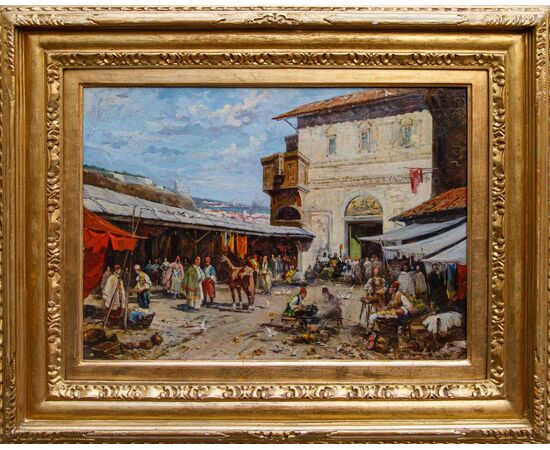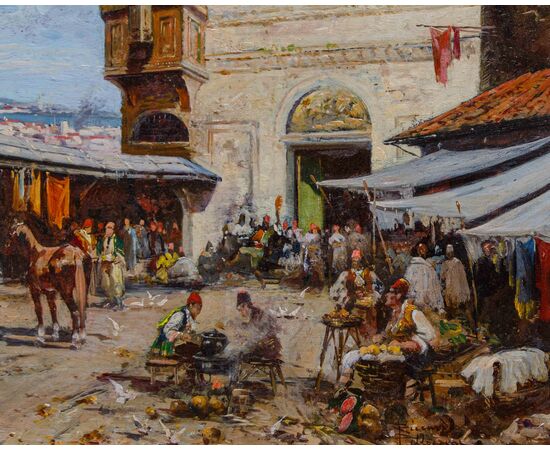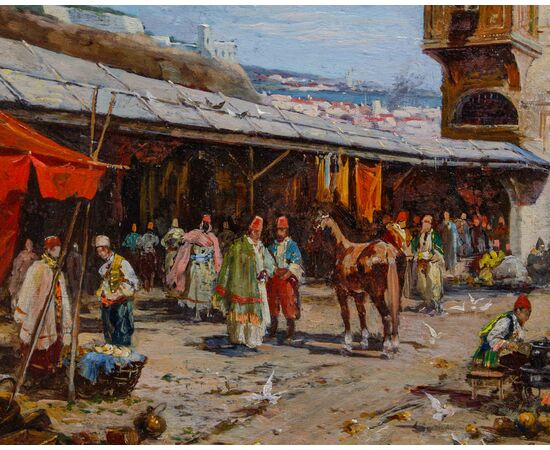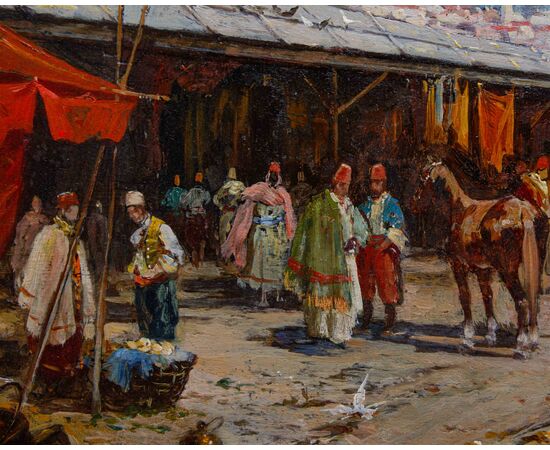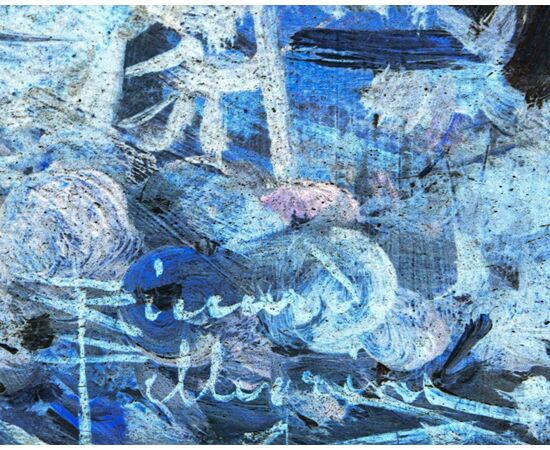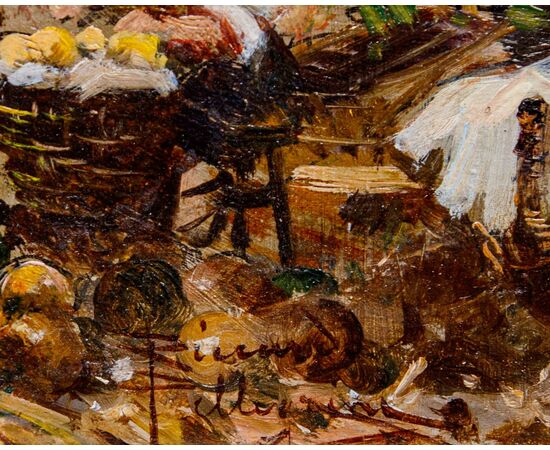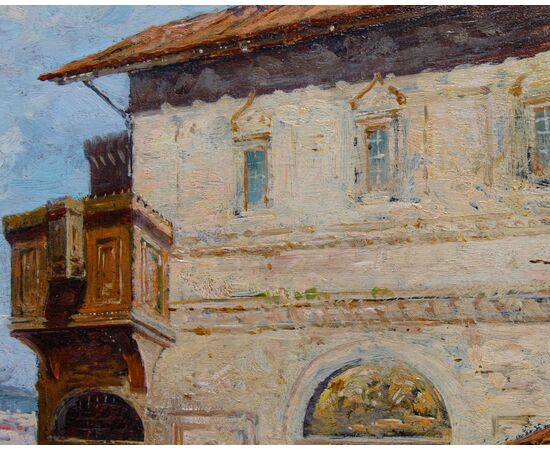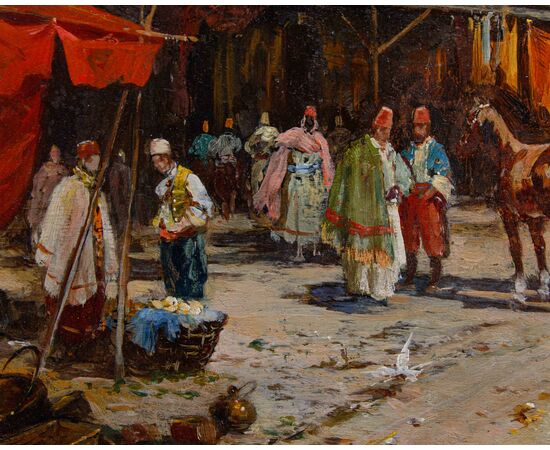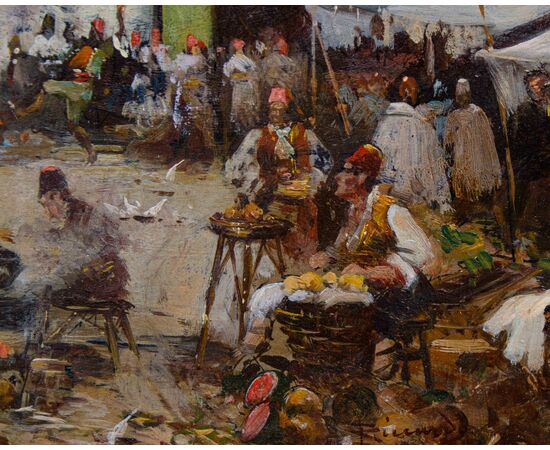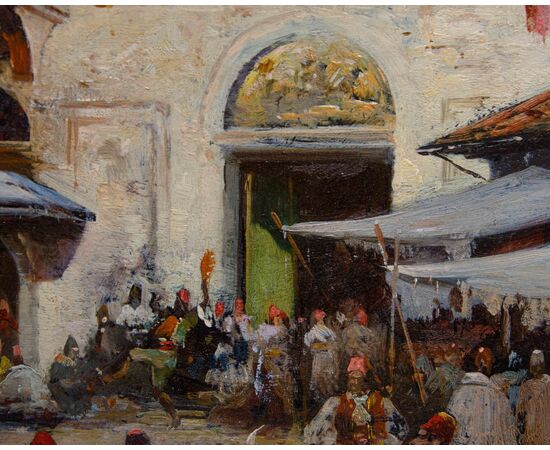Riccardo Pellegrini (Milan, 1863 – Crescenzago, 1934), Oriental Market
Riccardo Pellegrini (Milan, 1863 – Crescenzago, 1934)
Oriental Market
Oil on panel, 31.5 x 44.5 cm
With frame, 51 x 61 cm
Signed lower right
Riccardo Pellegrini, born in Milan in 1863, was a painter whose art, imbued with realism and a profound sensitivity to the changing times, offers us a vivid glimpse of Italy between the late nineteenth and early twentieth centuries. His artistic training began in the lively Milan of that period, a melting pot of cultural ferments and innovations, where he attended the Brera Academy. Here he was able to refine his technical skills and absorb the artistic trends of the time, while developing his own recognizable stylistic signature. Pellegrini was a versatile artist, capable of ranging from portraits to genre scenes, from urban landscapes to more intimate representations of daily life. What emerges strongly from his canvases is the ability to capture the essence of his subjects, whether they are figures from Milanese high society or humble commoners, with a rapid and turbulent brushstroke and a palette rich in nuances. His portraits, in particular, do not merely reproduce a physical likeness but often reveal the psychology of the characters, their states of mind, their aspirations. A distinctive aspect of his production is the predilection for scenes of contemporary life, often set in Italian cities. Milan, in particular, with its lively streets, its cafes, its theaters, was an inexhaustible source of inspiration. Pellegrini was an acute observer of the progress and social transformations that Italy was experiencing: the advent of industry, the changes in customs, the emergence of new social classes. In his works, one often senses a nostalgia for a world that was disappearing, but also the curiosity and enthusiasm for novelty. Although his production is mainly linked to Italy, Pellegrini was not an isolated artist. He traveled to various centers of the peninsula, including Naples – a city where he met Domenico Morelli, a master whose teachings were of particular impact in the elaboration of his visual imagery – and Pisa, and participated in several national and international exhibitions, receiving appreciations and recognitions that contributed to consolidate his reputation. His painting, although rooted in the late nineteenth-century figurative tradition, showed an attention to light and color that made it vibrant and modern, sometimes anticipating trends that would fully assert themselves only later. Significant for Pellegrini's existential and artistic experience is his stay in Spain around the early twentieth century: the trip to Spain inspired him for his rustic subjects and in his activity as an illustrator, which saw him create drawings for the major magazines of the time. Also in Spain, he illustrated Cervantes' Don Quixote and Alain-René Lesage's Gil Blas. Pellegrini died in Milan in 1934, leaving a significant artistic legacy. His works are now preserved in important public and private collections, testimony to an era and a talent that knew how to tell it with mastery and sensitivity: his paintings appear, for example, at the Civic Museums of Pavia (Outdoor Banquet) and the Accademia Carrara of Bergamo (Rustic Courtyard). His painting, rich in detail and full of humanity, continues to speak to contemporary observers, offering a window on a rapidly changing Europe, seen through the eyes of a painter deeply linked to the reality of his time. As evidence of the artist's great fortune already in the first quarter of the twentieth century, it is necessary to mention the personal exhibition of Bottega di Poesia, held in Milan in 1926, which included: "A carpet market in Spain"; "Winter quiet"; "July sun"; "An August morning in Toledo"; "Sea of Valencia"; "The newlyweds".
In this painting, which bears the artist's signature, Pellegrini represents, with his typical rapid and elusive brushstroke, a market scene. The daily life of the people is represented in an extremely truthful and realistic way, perfectly describing the atmosphere of the time.

